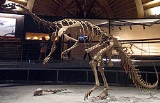
Plateosaurus
Overview
Plateosaurus is a genus
of plateosaurid
dinosaur
that lived during the Late Triassic
period, around 216 to 199 million years ago, in what is now Central and Northern Europe. Plateosaurus is a basal (early) sauropodomorph
dinosaur, a so-called "prosauropod". The latest research recognizes two species
: the type species
P. engelhardti from the late Norian
and Rhaetian
, and the slightly earlier P. gracilis from the lower Norian.
Genus
In biology, a genus is a low-level taxonomic rank used in the biological classification of living and fossil organisms, which is an example of definition by genus and differentia...
of plateosaurid
Plateosauridae
Plateosauridae is a family of plateosaurian sauropodomorphs. Plateosaurids were early sauropodomorph dinosaurs which existed in Asia, Europe and South America during the Late Triassic period. Although several dinosaurs have been classified as plateosaurids over the years, a 2007 study by Adam M....
dinosaur
Dinosaur
Dinosaurs are a diverse group of animals of the clade and superorder Dinosauria. They were the dominant terrestrial vertebrates for over 160 million years, from the late Triassic period until the end of the Cretaceous , when the Cretaceous–Paleogene extinction event led to the extinction of...
that lived during the Late Triassic
Triassic
The Triassic is a geologic period and system that extends from about 250 to 200 Mya . As the first period of the Mesozoic Era, the Triassic follows the Permian and is followed by the Jurassic. Both the start and end of the Triassic are marked by major extinction events...
period, around 216 to 199 million years ago, in what is now Central and Northern Europe. Plateosaurus is a basal (early) sauropodomorph
Sauropodomorpha
Sauropodomorpha is an extinct clade of long-necked, herbivorous, saurischian dinosaurs which includes the sauropods and their ancestral relatives. Sauropods generally grew to very large sizes, had long necks and tails, were quadrupedal, and became the largest animals to ever walk the Earth. The...
dinosaur, a so-called "prosauropod". The latest research recognizes two species
Species
In biology, a species is one of the basic units of biological classification and a taxonomic rank. A species is often defined as a group of organisms capable of interbreeding and producing fertile offspring. While in many cases this definition is adequate, more precise or differing measures are...
: the type species
Type species
In biological nomenclature, a type species is both a concept and a practical system which is used in the classification and nomenclature of animals and plants. The value of a "type species" lies in the fact that it makes clear what is meant by a particular genus name. A type species is the species...
P. engelhardti from the late Norian
Norian
The Norian is a division of the Triassic geological period. It has the rank of an age or stage . The Norian lasted from 216.5 ± 2.0 to 203.6 ± 1.5 million years ago. It was preceded by the Carnian and succeeded by the Rhaetian.-Stratigraphic definitions:The Norian was named after the Noric Alps in...
and Rhaetian
Rhaetian
The Rhaetian is in geochronology the latest age of the Triassic period or in chronostratigraphy the uppermost stage of the Triassic system. It lasted from 203.6 ± 1.5 to 199.6 ± 0.6 million years ago...
, and the slightly earlier P. gracilis from the lower Norian.
Unanswered Questions

